Tariffs Derail Expected Car Insurance Rate Drop: For much of 2024, drivers across the U.S. were cautiously optimistic. Industry analysts and insurance companies hinted at long-overdue relief: a predicted drop in car insurance premiums in 2025. With post-pandemic inflation cooling and vehicle repair costs stabilising, the forecast looked sunny.
But come early 2025, that optimism has taken a sharp U-turn.

New tariffs on auto parts and materials—especially from China and Mexico—are now reversing that trend. Instead of decreasing, insurance rates are either plateauing or rising again in many states. So, what changed, and why do international trade policies impact your monthly premium?
Table of Contents
Why Tariffs Derail The Expected Car Insurance Rate Drop in 2025?

Here’s what experts were banking on:
| Factor | Expected Impact |
|---|---|
| Supply chain issues had eased, bringing parts and labour costs down. | Supply chain issues had eased, bringing parts and labor costs down. |
| Post-Pandemic Driving Patterns | With fewer people commuting daily, accident rates slightly dropped. |
| Technological Improvements | Advanced safety features in newer vehicles were expected to reduce collision severity. |
| Insurance Market Competition | Supply chain issues had eased, bringing parts and labour costs down. |
Taken together, these trends suggested premiums could drop between 3% to 6% in 2025, according to data from the Insurance Information Institute (III).
What Changed? The 2025 Tariffs Car Insurance Rate Drop Explained
In early January 2025, the U.S. government implemented new tariffs on imported car parts and raw materials. These were aimed at pressuring global competitors and incentivising domestic manufacturing.
Here’s a simplified snapshot:
| Tariff Target | New Tariff Rate | Why It Matters |
|---|---|---|
| Chinese Auto Parts | +25% | Affects most electronics, sensors, and body parts. |
| Influences both the electric car costs and insurance. | +20% | Impacts structural repair materials. |
| EV Batteries (from Asia) | +30% | Influences both electric car costs and insurance. |
Insurance companies rely heavily on repair and replacement cost forecasts. As the prices of imported parts rise, so do the repair bills after accidents, which directly affect your premiums.
The Numbers: Where Rates Are Rising the Most
According to a Q1 2025 survey by Zebra Insurance, states with high vehicle density and import reliance are seeing the sharpest increases:
| State | Avg. Rate Increase (Q1 2025) |
|---|---|
| California | +7.2% |
| Texas | +6.8% |
| New York | +6.1% |
| Florida | +5.9% |
| Illinois | +4.7% |
Rural areas and states with a larger share of domestic vehicles (e.g., Michigan, Ohio) are seeing smaller increases, but few are escaping the tariff ripple effect altogether.
Looking Ahead: Will Rates Settle Down in Late 2025?
There’s hope, but not guarantees.
If trade tensions ease or automakers shift to domestic suppliers faster than expected, repair costs could stabilise by the second half of 2025. Until then, expect insurers to continue adjusting rates as they react to the financial impact of these tariffs.
The key takeaway?
What was once a hopeful drop in premiums is now a wait-and-see game. Staying informed and proactive can help you save hundreds—or even thousands—on your policy this year.
Conclusion on Car Insurance Rate Drop
Tariffs may seem like far-off economic tools, but their impact hits home in everyday costs, like car insurance. While 2025 was supposed to be the year of relief for American drivers, global trade decisions have thrown a wrench into those plans.
But all is not lost. By understanding what’s driving these increases and making smart insurance choices, you can still take control of your coverage—and your wallet.
Bhakti Rawat is a Founder & Writer of InsureMyCar360.com. This site Provides You with Information Related To the Best Auto Insurance Updates & comparisons. 🔗
